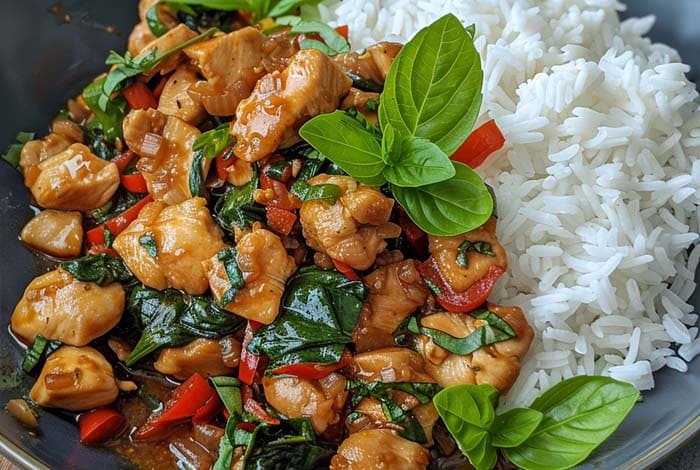Background and Origin
Spicy Thai Basil Chicken, also known in Thai as Pad Krapow Gai, is a staple dish in Thai cuisine with a rich history dating back to the heart of Thailand. It is a fast, flavorful dish commonly found in the bustling street markets and traditional Thai homes, showcasing the simplicity and depth of Thai cooking. The dish centers around the holy basil, a herb revered not only for its bold flavor but also for its purported health benefits, including stress reduction and blood sugar regulation. Spicy Thai Basil Chicken is a testament to the ingenuity of Thai cooking, utilizing readily available ingredients to create a dish bursting with flavor.
Popularity and Cultural Significance
The widespread love for Spicy Thai Basil Chicken extends far beyond Thailand’s borders, finding its way into the menus of Thai restaurants worldwide. Its appeal lies in its perfect balance of spicy, sweet, and savory elements, making it a quintessential representation of Thai culinary philosophy. The dish embodies the Thai cultural ethos of harmony and balance, both in its flavors and in its preparation. Eating Pad Krapow Gai is not just about enjoying a meal; it’s about experiencing a piece of Thai culture, where every bite tells a story of tradition, community, and the importance of food in bringing people together.
Flavor Profile and Key Ingredients
The flavor profile of Spicy Thai Basil Chicken is a complex harmony of heat, sweetness, and umami. Key ingredients include:
- Thai basil, with its spicy and slightly peppery flavor, distinguishes the dish from other basil-based recipes.
- Bird’s eye chilies provide a sharp, intense heat that is intrinsic to many Thai dishes.
- Garlic and shallots lay the aromatic foundation.
- Soy sauce, oyster sauce, and fish sauce contribute depth and umami, while a touch of sugar balances the heat and acidity.
These ingredients come together to create a dish that is at once bold and comforting, embodying the essence of Thai cuisine.
Ingredient List
- 400g of ground chicken: Lean and flavorful, perfect for quick cooking.
- 2 handfuls of Thai basil leaves: For that unmistakable aroma and taste.
- 3-5 bird’s eye chilies, finely sliced: Adjust according to your heat preference.
- 3 cloves of garlic and 2 shallots, finely chopped: For the aromatic base.
- 2 tablespoons of soy sauce: Adds saltiness and depth.
- 1 tablespoon of oyster sauce: For sweetness and umami.
- 1 teaspoon of fish sauce: For a burst of umami.
- 1 teaspoon of white sugar: To balance the flavors.
- 2 tablespoons of vegetable oil: For frying.
Substitutes:
- Italian basil can be used if Thai basil is unavailable, though the flavor will differ.
- Ground turkey or pork can replace chicken for variation.
Preparation Steps
- Heat the vegetable oil in a large skillet over medium-high heat.
- Add the garlic and chilies, sautéing until fragrant, about 1 minute.
- Increase the heat to high and add the ground chicken, breaking it apart with a spatula. Cook until no longer pink, about 5-6 minutes.
- Reduce the heat to medium. Stir in the soy sauce, oyster sauce, fish sauce, and sugar, mixing well to evenly coat the chicken.
- Continue to cook for another 2 minutes, allowing the sauces to thicken slightly and coat the chicken.
- Remove from heat and stir in the Thai basil leaves until wilted and fully integrated into the dish.
- Serve immediately with steamed jasmine rice for a complete meal.
Cooking Tips and Techniques
- For an authentic taste, use a mortar and pestle to pound the garlic and chilies before cooking. This releases their oils and enhances the flavor.
- Cooking on high heat is crucial for getting a good sear on the chicken, adding a layer of texture and flavor that defines Pad Krapow Gai.
- The sauce should be thick enough to cling to the chicken but not so thick that it becomes sticky. Adjust the heat as necessary to achieve the perfect consistency.
- Adding the basil at the very end preserves its vibrant color and ensures its flavor remains potent, bringing the dish to life with its aromatic freshness.
By following these steps and tips, you can bring the taste of Thailand into your kitchen with Spicy Thai Basil Chicken, a dish that is as nourishing for the soul as it is for the body.
Health Benefits
Spicy Thai Basil Chicken is not just a treat for the taste buds but also offers numerous health benefits. Thai basil, a key ingredient, is rich in vitamins A, C, and K, and has anti-inflammatory and antibacterial properties that can enhance the immune system. Chicken, the dish’s protein source, is low in fat but high in protein, essential for muscle growth and repair. The inclusion of chilies adds capsaicin to the diet, which is known for its metabolism-boosting properties. Together, these ingredients make Spicy Thai Basil Chicken a healthful choice that supports overall wellness.
Caloric and Nutritional Breakdown
A single serving of Spicy Thai Basil Chicken is both nutritious and calorie-conscious, with approximately 300 calories per serving. This dish provides about 25 grams of protein, essential for building and repairing tissues, and only 10 grams of carbohydrates, making it an excellent option for those on a low-carb diet. The dish is also a good source of iron and vitamins, thanks to the Thai basil and the vegetables often served alongside it. Its moderate fat content, coming primarily from the vegetable oil, ensures that the dish is satisfying yet still fits within a balanced diet.
Variations of the Dish
Spicy Thai Basil Chicken boasts several regional variations that reflect the diverse culinary landscape of Thailand. In the northeastern region, known as Isaan, a version includes ground roasted rice, adding a nutty flavor and texture to the dish. In the southern parts of Thailand, cooks often add coconut milk for a creamy, rich dimension that contrasts beautifully with the heat of the chilies. Another popular variation involves the use of different proteins, such as duck or pork, offering a different taste profile and texture but retaining the essential flavors of the original recipe.
Customization for Dietary Restrictions
The versatility of Spicy Thai Basil Chicken allows for various modifications to cater to dietary restrictions:
- Vegetarian and Vegan: Substitute the chicken with tofu or tempeh to maintain the protein content without compromising on flavor. Use a combination of mushroom sauce and soy sauce as alternatives to fish and oyster sauces.
- Gluten-Free: Opt for gluten-free soy sauce and ensure that all other sauces used are certified gluten-free.
- Low-Calorie: Reduce the oil used for cooking or opt for a non-stick spray. Increase the quantity of vegetables, such as bell peppers and green beans, to add bulk and fiber without significantly increasing calories.
These adaptations ensure that Spicy Thai Basil Chicken can be enjoyed by everyone, regardless of dietary preferences or restrictions, making it a truly inclusive dish.
Serving and Pairing Suggestions
Side Dishes
Spicy Thai Basil Chicken is best complemented with side dishes that can either enhance its flavors or provide a refreshing contrast. A popular choice is steamed jasmine rice, which acts as a neutral base to soak up the rich sauce. For a healthier option, brown rice or quinoa can be used. Stir-fried vegetables, such as bok choy, bell peppers, or green beans, add color and nutrition to the meal. A cucumber salad dressed with vinegar provides a cooling effect, balancing the dish’s spiciness. Lastly, a side of clear soup, like a simple chicken or vegetable broth, can cleanse the palate and make the meal more satisfying.
Wine and Beverage Pairings
When pairing drinks with Spicy Thai Basil Chicken, the goal is to either complement the dish’s fiery flavors or provide a soothing counterbalance. For wine enthusiasts, a slightly sweet Riesling or a crisp Sauvignon Blanc works well, as their acidity and fruitiness can stand up to the heat. For a non-alcoholic option, a chilled glass of coconut water can be refreshing and hydrating. Beer lovers might appreciate a light lager or a wheat beer, whose mild flavors and carbonation help cleanse the palate. Finally, for those who prefer cocktails, a lemongrass or basil-infused gin and tonic can echo the dish’s herbal notes while adding a refreshing twist.
FAQs
Can I substitute Thai basil with another type of basil?
- While Thai basil is preferred for its unique flavor, Italian basil can be used as a substitute in a pinch. The dish will have a different flavor profile but will still be delicious.
How long can I store leftover Spicy Thai Basil Chicken?
- Leftovers can be stored in an airtight container in the refrigerator for up to 3 days. Reheat gently in a pan over low heat to maintain the texture of the basil.
What are some serving recommendations for Spicy Thai Basil Chicken?
- For a traditional Thai meal, serve Spicy Thai Basil Chicken with steamed jasmine rice. For a low-carb option, cauliflower rice makes a great substitute. To round out the meal, add a side of stir-fried vegetables or a fresh salad.
Can I make this dish vegetarian or vegan?
- Yes, the chicken can be substituted with tofu, tempeh, or a mix of mushrooms for a vegetarian or vegan version. Use soy sauce or a vegan fish sauce alternative to keep the dish vegan.
Is Spicy Thai Basil Chicken spicy, and can I adjust the heat?
- The dish is traditionally spicy, but you can adjust the heat level by reducing or omitting the bird’s eye chilies. Alternatively, add more chilies if you prefer extra heat.

Spicy Thai Basil Chicken Recipe
Equipment
- Large skillet or wok
- Spatula
- Knife
- Cutting board
Ingredients
- 400 g ground chicken
- 2 cups Thai basil leaves
- 3-5 bird's eye chilies finely chopped (adjust to taste)
- 3 cloves garlic minced
- 2 shallots finely chopped
- 2 tablespoons soy sauce
- 1 tablespoon oyster sauce
- 1 teaspoon fish sauce
- 1 teaspoon white sugar
- 2 tablespoons vegetable oil
- Steamed jasmine rice for serving
Instructions
- Prep Ingredients: Mince the garlic, chop the shallots, and finely chop the bird's eye chilies. Set aside.
- Cook Chicken: Heat oil in a large skillet over medium-high heat. Add garlic, chilies, and shallots, sautéing until fragrant, about 1 minute. Add the ground chicken, breaking it apart with a spatula, and cook until no longer pink, about 5-6 minutes.
- Add Sauces: Lower the heat to medium. Stir in soy sauce, oyster sauce, fish sauce, and sugar. Mix well and cook for another 2 minutes until the sauce has thickened slightly.
- Finish with Basil: Remove from heat. Stir in Thai basil leaves until they wilt and are well incorporated into the chicken.
- Serve: Immediately serve the Spicy Thai Basil Chicken over steamed jasmine rice.
Notes
- Basil Substitution: If Thai basil is unavailable, Italian basil can be used as a substitute, though the flavor will be different.
- Adjusting Spice Levels: The number of chilies can be adjusted to make the dish more or less spicy according to your preference.
- Dietary Adaptations: For a vegetarian or vegan version, substitute chicken with tofu or tempeh and use vegetarian oyster sauce and soy sauce.
- Storage: Store leftovers in an airtight container in the refrigerator for up to 3 days. Reheat gently before serving.

